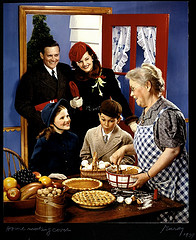Theme Essay by Emily Toth
Never Trust the Lean and Hungry
I was a gawky teen when I found out from Shakespeare that skinny people can’t be trusted. Julius Caesar says it all:
Let me have men about me that are fat; Sleek-headed men and such as sleep o' nights; Yond' Cassius has a lean and hungry look; He thinks too much: such men are dangerous.
Caesar wasn’t talking about the likes of me. I wasn’t a man, nor was I wearing a toga (toga parties hadn’t yet made it to Lakewood, Ohio). But he was right, of course, about Cassius, the lean and hungry. He’s the one who kills the great Caesar.
 And so I learned never to trust people who like to deprive themselves. They ruminate and turn sour. They’re in that never-ending brigade of bullies who can’t abide the idea that someone, somewhere, is having fun.
And so I learned never to trust people who like to deprive themselves. They ruminate and turn sour. They’re in that never-ending brigade of bullies who can’t abide the idea that someone, somewhere, is having fun.Luckily for me, my mother came from an immigrant culture, only one generation removed from theshtetl. Eating was treasured. The anxious table talk was always “Did you get enough to eat?” and never “Put that down. You’ll get fat.” Food was for feasting, and it was great praise if you were called “a good eater.” It meant that you were someone with a zesty appetite, a company charmer.
I grew up to be a foodie and a woman of size—totally trustworthy. So believe me when I say that anyone who thinks gluttony is a sin is…a fool.
• • •
Long before Shakespeare’s Caesar, the original Romans got a kick out of eating for pleasure. At the first Roman feast I ever read about, in Petronius’s Satyricon, the rich man Trimalchio puts on an awesome feed. He’s got a hare tricked out with wings—a rabbity Pegasus. He’s got all the Zodiac signs represented by foods, including Gemini with testicles and kidneys. His gravy boats are shaped like satyrs with giant phalluses. The pastry eggs are filled with live orioles, and when the roast boar is carved, live thrushes fly out, flapping and cawing.
It’s a scene of wretched excess—Las Vegas on the Tiber—and it makes turducken seem like Lean Cuisine. But is it about the evils of gluttony—or just hilariously bad taste?
 I could ask the same about Rabelais’s Gargantua and Pantagruel, a rollicking opus of monster feedings. The giant Gargantua’s appetizers alone consist of several dozen hams, beef tongues, caviar, and fried tripe, washed down with wine to clear his kidneys for the next round. He also does graphic recycling: “fine turds, tweak-nose style,” “shitlets,” “collared bullfarts,” and, for dessert, “shit drench with blossoming turds.”
I could ask the same about Rabelais’s Gargantua and Pantagruel, a rollicking opus of monster feedings. The giant Gargantua’s appetizers alone consist of several dozen hams, beef tongues, caviar, and fried tripe, washed down with wine to clear his kidneys for the next round. He also does graphic recycling: “fine turds, tweak-nose style,” “shitlets,” “collared bullfarts,” and, for dessert, “shit drench with blossoming turds.”
As far as I can tell, it’s more about slapstick than “overeating”—but it does present humungous dining as an enjoyable sport.
Dumping on gluttony certainly doesn’t come from the Hebrew Bible, where celebrations require feasts. The prophet Isaiah says:
Eat ye that which is good, and let your soul delight itself in fatness.
Jesus was also a foodie, who produced loaves and fishes to feed the multitudes. When his Jewish mother worried about having enough for wedding guests to drink, he obligingly turned water into wine.
The idea that eating could be a sin—rather than a delight—may go back to that killjoy apostle Paul, who carried on against lust, same-sex relations, and serving one’s belly. After him, the early Christian fathers railed about “the flesh” and women and sensual enjoyments as social problems—while seeming not to notice polygamy and slavery.
When Pope Gregory the Great codified the “Seven Deadly Sins” in the sixth century, he listed gluttony along with pride, envy, sloth, anger, greed, and lust—but he somehow left out cruelty. He even obsessively listed five aspects of gluttony: eating too soon, too delicately, too expensively, too greedily, and too much.
I think he suffered from misplaced priorities.
By the time we get to Dante in the fourteenth century, gluttons have taken their place in the Third Circle of Hell. They’re in a stinking bog, where they’re perpetually pelted with rain, hail, and snow. Instead of eating, they howl like dogs.
There were a few dissenters. Thomas Aquinas was one theologian who didn’t condemn gluttony—because he was a jolly fellow who liked to eat. Heretical sects like the Carpocratians took pleasure in orgies of all kinds, and the Gnostics reportedly ate menstrual blood and semen with lentils. (I once tried to publish that in the 1970s, and an editor said “Eww” and wouldn’t print it. Maybe I’ll have better luck now.)
So, for hundreds of years—maybe until the invention of the printing press—it was hard to get much written, or preserved, about eating with gusto. I wonder if making “gluttony” a sin was a way of telling people who were starving (as most were) that they were virtuous. I wonder how you say in Latin, “You’ll have pie in the sky when you die.”
Then the French, the archfoodies of the world, saved us. According to Adam Gopnik in The Table Comes First, France by the nineteenth century had solved the problems of food distribution and so could bring about the birth of the restaurant. They invented the sauces, they drank the wine, and they created a secular worship of food that still exists today. Julia Child brought that religion to the United States, to our great joy.
• • •
Gluttony is good for writers. Food fuels the brain, and megadoses of caffeine have always been the writer’s drug. Honoré de Balzac would write in a frenzy, hunkered down in his monk’s costume, drinking twenty cups of coffee a day. A. J. Liebling’s muse was food, and he wrote as a formidable eater whose capacity was called “Rabelaisian.”
Alas, most food celebrations have been written by men. Women are the cooks, the nurturers, but men get the glory and are allowed to eat all they want in public. Medieval writers joked about well-fed monks, but nuns were savaged for ostentatious…fasting.
No one writes about starvation with zest. “Watching your weight,” with its corrosive vocabulary (“calories,” “dieting”), is one of the most tedious subjects on earth. One even hears about it—to my horror—at dinner parties, where people pick at their food instead of relishing every tasty morsel and cherishing the cook.
Yes, gluttony-as-sin has made a comeback. There are, dwelling among us, people with a quasi-religious belief that thinness is godliness. They even use the language of religion. They confess their “sins”: “I couldn’t resist that tempting chocolate.” Or they brag: “I was so good. I didn’t have any of that delicious pie.”
People starve themselves, not for spiritual grace but for pride and vanity. They also look for someone to blame.
Chef-author Anthony Bourdain, for instance, has called fellow chef Paula Deen “the worst, most dangerous person in America” for her love of butter. Her being diagnosed with diabetes also led to some fairly horrific examples of schadenfreude on the Net.
Bourdain is noticeably skinny, bordering on a lean and hungry look, but does that make him virtuous? Most likely, it means that he has a sprightly metabolism, since weight and size are mostly determined by our genes. Norwegians aren’t sumo wrestlers; Samoans aren’t willowy runway models.
I’m neither willowy nor sumo, and I doubt if I’ll ever have a lean and hungry look. My favorite writers tell me that eating well is one of life’s supreme pleasures.
I am not a glutton for punishment.
Good Readings
- “The Joy of Cooking and the Malleus Maleficarum” by Gina Barreca, Chronicle of Higher Education blog, June 7, 2012.
- “The Ancient Sin of Gluttony: What’s Really Behind the Shunning of Paula Deen” by Cynthia Bertelsen, Gherkins & Tomatoes: A Writer’s Meditations, Jan. 26, 2012.
- My Life in France by Julia Child and Alex Prud’homme (Knopf, 2006).
- Lost Christianities: The Battles for Scripture and the Faiths We Never Knew by Bart Ehrman (Oxford University Press, 2005).
- “A Brazilian from Pope Calixtus,” [Rabelais] by Lucy Ellmann, The Guardian, December 22, 2006.
- The Table Comes First: Family, France, and the Meaning of Food by Alan Gopnik (Vintage, 2012).
- “The Deadliest Sin” by Jim Holt, Boston Globe, Nov. 23, 2003.
- “The Novelist Who Loved Food” [Balzac] by Nancy Kline, New York Times, December 2, 2011.
- The Strange History of Suzanne LaFleshe and Other Stories of Women and Fatness edited by Susan Koppelman (Feminist Press, 2003).
- Between Meals: An Appetite for Paris byA. J. Liebling, (North Point Press, 2004).
- The Above-Average Typist: Useful information on The Satyricon by Petronius.
- Gluttony (The Seven Deadly Sins) by Francine Prose (Oxford University Press, 2003).
- Feast: A History of Grand Eating by Roy C. Strong, (Houghton Mifflin Harcourt, 2003).
- Fat! So? Because You Don’t Have to Apologize for Your Size by Marilyn Wann (Ten Speed Press/Random House, 1998).
Art Information
- "McCall's Magazine Cover, Family Arriving in Kitchen for the Holidays" © Nickolas Muray, 1939; George Eastman House Photography Collection; public domain
- "Cream of Wheat, Boy with Cookies" © Nickolas Muray, 1936; George Eastman House Photography Collection; public domain

Emily Toth is a contributing writer at Talking Writing, where her column “Nothing but the Toth” appears regularly.
"When my mother hated Nature, she was saying she preferred stories about things—and people—that mattered. She never met a cow she liked. Nor did Kate Chopin, who was once forced to milk a cow when farm hands didn’t show up." — "The Outdoors is Not in My Nature"

